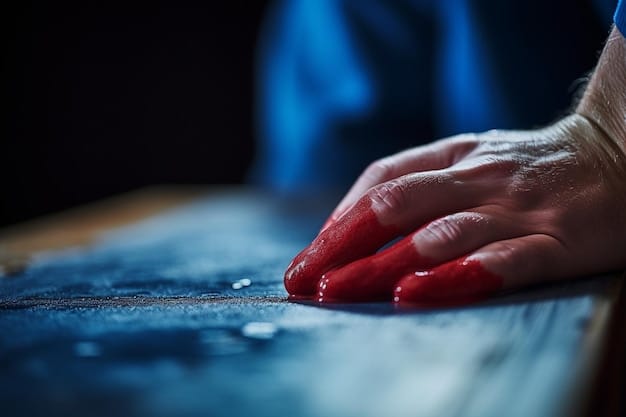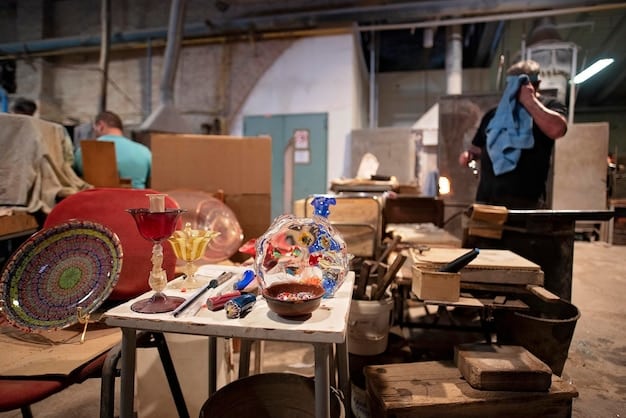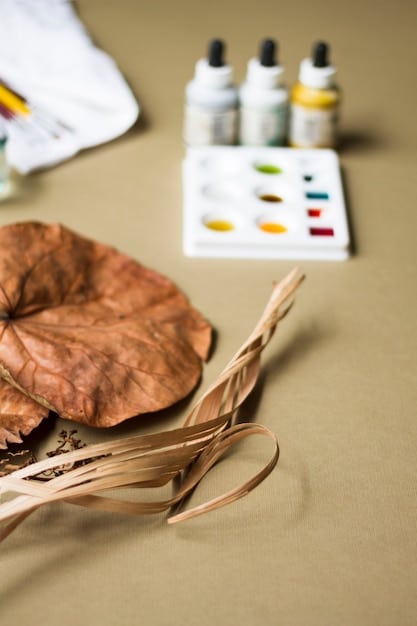Designer Spotlight: American Craftsman Bringing Tradition to Modern Design

This designer spotlight shines on an American visionary who’s masterfully blending traditional craftsmanship with modern design aesthetics, creating timeless pieces reflecting heritage and innovation.
In the realm of design, where innovation often overshadows tradition, a remarkable American designer is emerging, breathing new life into age-old crafts. This Designer Spotlight: The American Designer Reviving Traditional Craftsmanship in the Modern Era, celebrates the fusion of heritage and contemporary design, highlighting an artist dedicated to preserving invaluable skills while shaping the future of aesthetics.
Discovering the Roots of Traditional Craftsmanship
To truly appreciate the ingenuity of modern design intertwined with traditional methods, one must first understand the profundity behind these crafts. Far from being relics of the past, these techniques represent a cultural inheritance, bearing the hallmark of generations and reflecting diverse communal narratives.
The Significance of Preserving Traditional Crafts
Traditional craftsmanship embodies a wealth of cultural knowledge. Each technique, tool, and material carries stories of its origin. These crafts often reflect natural resources, societal structures, and shared experiences, symbolizing more than mere objects; they embody the spirit and soul of a community.
Challenges Faced by Traditional Artisans Today
In today’s fast-paced, mechanized world, traditional artisans face numerous challenges. Mass production overshadows unique, handcrafted items. Younger generations often overlook preserving these crafts, opting for more conventional career paths, leading to a decline in the skill base, endangering these invaluable traditions.
- Economic viability concerns among traditional artisans.
- Lack of awareness and appreciation from consumers.
- Difficulty competing with mass-produced, low-cost alternatives.
- Finding avenues to pass on skills to younger generations.

The contemporary designer’s conscious decision to incorporate traditional craftsmanship is a powerful statement. It’s an acknowledgment of the invaluable stories and expertise embedded within these practices.
Meet the American Designer: A Fusion of Past and Present
At the heart of this revitalization movement stands a visionary American designer, one who is passionately committed to combining traditional craft techniques with contemporary design principles. This harmonious fusion not only gives new life to heritage skills but also creates unique, timeless pieces that resonate with modern audiences.
The Designer’s Background and Influences
This designer’s journey often begins with a deep appreciation for their cultural heritage, coupled with formal training in modern design. Inspirations may stem from diverse, eclectic sources ranging from ancestral techniques to avant-garde artistic movements, resulting in a nuanced and holistic creative perspective.
Commitment to Sustainable and Ethical Practices
Sustainability and ethical considerations are essential components in the designer’s creative process. By using locally sourced materials and supporting regional artisans, they’re able to minimize environmental impact and empower local communities, thereby ensuring that traditional crafts remain relevant and sustainable for future generations.
- Sourcing local, sustainable materials for creations.
- Supporting local artisans through collaborations.
- Implementing ethical labor practices.
- Reducing waste and promoting eco-friendly production methods.
This blend of responsibility and artistry results in products that possess a deep level of integrity and authenticity, appealing to consumers who value both aesthetic appeal and genuine impact.
Reviving Lost Arts: Innovative Techniques and Materials
A vital aspect of the designer’s mission involves exploring and reviving lost arts. This requires extensive research, experimentation, and collaboration with master artisans to unlock the full potential of these nearly forgotten crafts.
Incorporating Traditional Weaving Techniques
Textiles hold a significant place in traditional craftsmanship, bearing the stories of cultures through intricate patterns and techniques. By mastering and incorporating methods such as hand-loom weaving, the designer creates stunning textiles that add depth, texture, and historical context to their creations.
Using Natural Dyes and Sustainable Materials
The reintroduction of natural dyes marks a departure from synthetic alternatives, enabling vibrant, nuanced colors derived from plants, minerals, and insects. Paired with sustainable materials like organic cotton, hemp, and recycled fibers, the designer ensures that their work is environmentally considerate and aesthetically pleasing.
- Experimenting with forgotten dyeing methods.
- Promoting the use of indigenous plant dyes.
- Reducing chemical waste in textile production.
- Ensuring material sourcing adheres to fair trade principles.
Each piece reflects a devotion to preserving disappearing traditions while contributing to a more planet-friendly ethos within the design industry.

Collaborative Partnerships: Empowering Artisans and Communities
Realizing the full potential of this mission requires building collaborative partnerships with artisans and communities. Through these alliances, the designer not only supports skill preservation but also promotes economic empowerment.
Working Directly with Artisan Cooperatives
Establishing direct relationships with artisan cooperatives ensures that traditional craftspeople receive fair compensation, access to global markets, and respect for their cultural heritage. These partnerships help foster sustainable economic growth while preserving invaluable skills for future generations.
Providing Training and Resources for Artisans
Beyond economic support, providing training and resources is critical for ensuring the continuity of traditional crafts. Workshops, educational programs, and access to modern tools enable artisans to refine their skills adapt to evolving market demands, thereby securing their legacy.
- Organizing skill-sharing workshops between generations.
- Providing access to technology and design software.
- Facilitating participation in trade shows and exhibitions.
- Offering micro-loans for small-scale craft businesses.
These collaborative efforts help build a robust ecosystem where artisans thrive, and ancestral crafts prosper.
Showcasing Craftsmanship in Contemporary Design
The true measure of this designer’s impact lies in his ability to integrate traditional craftsmanship into contemporary design seamlessly. By combining old techniques with modern aesthetics, the designer creates pieces that are both culturally rich and relevant.
Furniture Design: Blending Heritage with Modern Living
In furniture design, this often entails using traditional joinery techniques to create sleek, minimalist pieces. Wooden furniture crafted with dovetail joints, intricate carvings, and hand-applied finishes showcase the beauty of artisanal work while meeting the demands of modern living spaces.
Fashion and Accessories: Elevating Traditional Textiles
In the realm of fashion, the designer elevates traditional textiles by incorporating handwoven fabrics into modern silhouettes. By incorporating intricate embroideries and dyeing techniques into contemporary styles, they promote cultural heritage while creating unique, high-end fashion items.
- Designing clothing with handwoven and naturally dyed textiles.
- Creating accessories with traditional beadwork.
- Incorporating traditional patterns into modern designs.
- Collaborating with artisans to produce one-of-a-kind pieces.
Through innovative application, the designer breathes new life into these crafts, ensuring their place in the contemporary world.
The Impact: Preserving Heritage and Inspiring Future Generations
The impact of this designer extends far beyond aesthetics, touching on cultural preservation and the inspiration they provide to future creative minds. By demonstrating the value of traditional craftsmanship, they encourage others to explore and embrace their heritage.
Creating Awareness and Appreciation for Traditional Crafts
Through exhibitions, workshops, and media coverage, the designer raises awareness about traditional crafts, highlighting their cultural significance and the importance of preserving them. This increased visibility fosters a deeper appreciation among consumers, driving sales and supporting artisan communities.
Inspiring Young Designers to Embrace Heritage
By serving as a role model, the designer inspires young creatives to explore their own cultural heritage and incorporate traditional craftsmanship into their work. This mentorship helps diversify the design landscape and ensures that these invaluable skills are passed on to future generations.
- Mentoring young designers and artisans.
- Creating educational programs in collaboration with local communities.
- Showcasing traditional crafts in contemporary contexts.
- Providing resources and platforms for emerging artisans.
The designer acts as a catalyst for cultural revitalization, ensuring that traditional crafts continue to thrive in the modern age.
| Key Point | Brief Description |
|---|---|
| 🔑 Preservation | Reviving and safeguarding traditional arts and crafts. |
| 🤝 Collaboration | Partnering with artisans and cooperatives to empower communities. |
| 🌱 Sustainability | Using ethical practices and sustainable materials to minimize impact. |
| 💡 Innovation | Blending time-honored methods with cutting-edge design. |
Frequently Asked Questions
▼
Traditional craftsmanship embodies skills and techniques passed down through generations. It reflects cultural heritage and relies on manual skill rather than mass production, creating unique, authentic goods.
▼
Preserving traditional crafts safeguards cultural identity, promotes sustainable practices, and supports local artisan communities. It ensures that irreplaceable knowledge and skills continue to thrive for generations.
▼
The designer blends traditional and modern design by incorporating age-old techniques into contemporary forms. This includes using handwoven textiles in modern silhouettes and traditional joinery in minimalist furniture.
▼
The designer employs sustainable practices such as sourcing local materials, using natural dyes, and supporting fair trade principles. These actions reduce environmental impact and promote ethical production of goods.
▼
Collaborative partnerships benefit artisans by providing fair compensation, access to broader markets, and resources for training. This support empowers artisans and ensures the sustainability of their craft.
Conclusion
The journey of the American designer highlighted in this spotlight is a testament to the power of blending tradition with innovation. By championing age-old crafts, fostering collaborative partnerships, and embracing sustainable practices, they are not only creating unique, timeless designs but also ensuring that invaluable cultural heritage thrives for generations to come.





